Part 3: Joy
Note: This is part 2 of a 4 part series. See Part 1 and Part 2 here.

Introduction:
I have a deep aspiration to bring LOVE back in to medicine. Love is not a word we use much in medicine, and for some very good reasons. It has become misunderstood or cheapened through the way it has been used and/or abused in popular discourse. At the same time, love is at the root of why many of us chose to enter the healing professions, as a calling, not just a job. Love is part of my personal definition of mindfulness (adapted from Jon Kabat-Zinn): Paying attention in a particular way, on purpose, in the present moment, and with unconditional love. We need to tend to this precious root, so that it can become a beautiful flower. Like any other living thing, if we don’t tend to it, it will wither and weaken. If this happens, we may run out of the energy and aspiration we need to sustain ourselves in this sacred work.
WHY do we love? My mentor, Dr. Kenneth Ginsburg (Adolescent Medicine Pediatrician, Children’s Hospital of Philadelphia and University of Pennsylvania) says, “We love so that people know that they’re worthy of being loved. Love can bring us energy and courage to face pain and suffering. Love can provide us connection and meaning in our work, and in our lives.
WHAT is love? This four-part series will examine what Zen Master Thich Nhat Hanh describes as the Four Elements of True Love, and how they can enrich our work in medicine. This is the first piece of the series.
"True love is made of four elements: loving kindness, compassion, joy, and inclusiveness. - Sister Peace |
I am so glad I chose to work in pediatrics. Children and youth are naturally playful and creative, even in the midst of illness. Children and youth learn through PLAY… and so can adults, when we are able to stay in touch with our innate sense of curiosity and wonder in life!
When children and youth experience painful illness and/or treatments, we have an opportunity to bring some joy and lightness into difficult moments. Walking around BC Children’s Hospital, I sometimes see and hear music, dancing, singing, clowns, and ice cream. These experiences lighten my steps, and I hope it is a small balm to our brave patients, families, and colleagues as well.
I remember one patient I cared for on the inpatient ward, who needed to undergo some tremendously difficult, but life-saving, treatments. We turned those moments into nail painting parties (she painted MY nails!), we danced to Taylor Swift, we celebrated big and small successes together. We laughed through the pain. Without denying the difficulties that we were in, we were able to get through them together.
All of these moments of joy can help us to cultivate loving relationships with those we serve. Joy can serve as a fuel for the energy and motivation that we need to continue forward on the healing journey. Perhaps we can even learn to hold our tears with a gentle smile, like a loving parent holds a crying baby.
Invitation to Contemplate: What is one small act of joy that you shared, received, offered, or witnessed in health care in the past week? Perhaps it was with a patient, or colleague, or trainee, or caregiver. Take a moment to recall this situation, who was there, what the moment of joy was, and how it made you and the other person(s) feel. Feel free to write some reflections in a journal, or share them with a trusted friend.
I love hearing laughter at work. Laughter in the hallways, with my colleagues and our adolescent patients. Laughter, bringing energy and motivation to continue to overcome challenges. Shared laughter, bringing healing and connection in times of suffering.